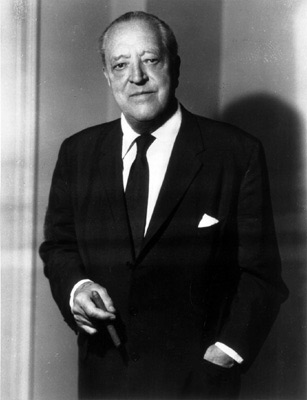
Ludwig Mies van der Rohe was a German-American architect and furniture designer. He was commonly referred to as Mies, his surname. Along with Alvar Aalto, Le Corbusier, Walter Gropius and Frank Lloyd Wright, he is regarded as one of the pioneers of modernist architecture.
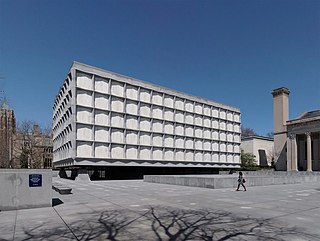
The Beinecke Rare Book & Manuscript Library is the literary archive and special collections of the Yale University Library in New Haven, Connecticut. It is one of the largest buildings in the world dedicated to rare books and manuscripts. Established as a gift of the Beinecke family and given its own financial endowment, the library is financially independent from the university and is co-governed by the University Library and Yale Corporation.

The University of Sheffield is a public research university in Sheffield, South Yorkshire, England. Its history traces back to the foundation of Sheffield Medical School in 1828, Firth College in 1879 and Sheffield Technical School in 1884. University College of Sheffield was subsequently formed by the amalgamation of the three institutions in 1897 and was granted a royal charter as University of Sheffield in 1905 by King Edward VII.

Sheffield Town Hall is a municipal building on Pinstone Street in the City of Sheffield, England. The building is used by Sheffield City Council, and also contains a publicly displayed collection of silverware. It is a Grade I listed building.

The Canadian Museum of Nature is a national natural history museum based in Canada's National Capital Region. The museum's exhibitions and public programs are housed in the Victoria Memorial Museum Building, a 18,910-square-metre structure (203,500 sq ft) in Ottawa, Ontario. The museum's administrative offices and scientific centres are housed at a separate location, the Natural Heritage Campus, in Gatineau, Quebec.
Brutalist architecture is an architectural style that emerged during the 1950s in the United Kingdom, among the reconstruction projects of the post-war era. Brutalist buildings are characterised by minimalist constructions that showcase the bare building materials and structural elements over decorative design. The style commonly makes use of exposed, unpainted concrete or brick, angular geometric shapes and a predominantly monochrome colour palette; other materials, such as steel, timber, and glass, are also featured.

The Toronto-Dominion Centre, or TD Centre, is an office complex of five skyscrapers in the Financial District of downtown Toronto owned by Cadillac Fairview. It serves as the global headquarters for its anchor tenant, the Toronto-Dominion Bank, and provides office and retail space for many other businesses. The complex consists of six towers and a pavilion covered in bronze-tinted glass and black-painted steel. Approximately 21,000 people work in the complex, making it the largest commercial office complex in Canada.

RMIT University, officially the Royal Melbourne Institute of Technology, is a public research university in Melbourne, Australia.
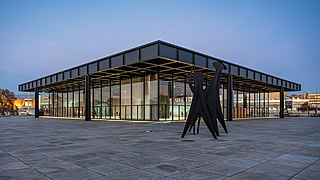
The Neue Nationalgalerie at the Kulturforum is a museum for modern art in Berlin, with its main focus on the early 20th century. It is part of the National Gallery of the Berlin State Museums. The museum building and its sculpture gardens were designed by Ludwig Mies van der Rohe and opened in 1968.
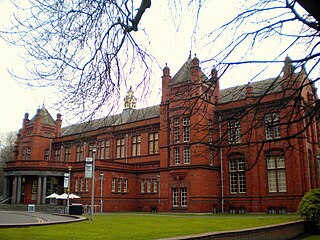
The Whitworth is an art gallery in Manchester, England, containing about 55,000 items in its collection. The gallery is located in Whitworth Park and is part of the University of Manchester.
The Maryland Institute College of Art (MICA) is a private art and design college in Baltimore, Maryland. Founded in 1826 as the Maryland Institute for the Promotion of the Mechanic Arts, it was regarded as one of the oldest art colleges in the United States.
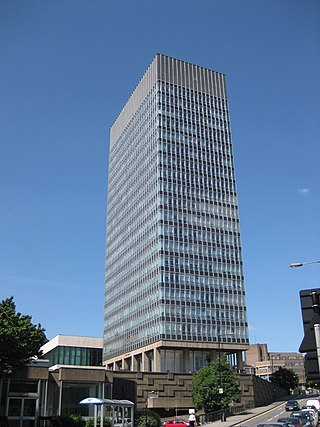
The Arts Tower is a building at 12 Bolsover Street in Sheffield, England, belonging to the University of Sheffield and which opened in 1965. A spokesperson for English Heritage described it as "the most elegant university tower block in Britain of its period". At 78 m (256 ft) tall, it is the second-tallest building in the city, after the 101 m (331 ft) St Paul's Tower on Arundel Gate, which was topped out in 2009. Mitchell Construction a British civil engineering firm, built the Arts Tower. Photographs from their topping out ceremony in October 1964 help to document a different era in UK working conditions.

Glasgow University Library in Scotland is one of the oldest and largest university libraries in Europe. At the turn of the 21st century, the main library building itself held 1,347,000 catalogued print books, and 53,300 journals. In total, the university library system including branch libraries now holds approximately 2.5 million books and journals, along with access to 1,853,000 e-books, and over 50,000 e-journals. The University also holds extensive archival material in a separate building. This includes the Scottish Business Archive, which alone amounts to 6.2 kilometers of manuscripts.

Firth Court is a Grade II listed Edwardian red-brick building that forms part of the Western Bank Campus of the University of Sheffield in the United Kingdom. Located on the northern side of Western Bank, it is the main administrative centre for the university and also houses the Departments of Molecular Biology and Biotechnology and Biomedical Science.

The Henry Clay Frick Fine Arts Building is a landmark Renaissance villa and a contributing property to the Schenley Farms-Oakland Civic Historic District on the campus of the University of Pittsburgh in Pittsburgh, Pennsylvania, United States. The Frick Fine Arts Building sits on the southern edge of Schenley Plaza, opposite The Carnegie Institute, and is the home of Pitt's History of Art and Architecture Department, Studio Arts Department, and the Frick Fine Arts Library. Before its front steps is Mary Schenley Memorial Fountain.

Arts Club of Chicago is a private club and public exhibition space located in the Near North Side community area of Chicago, a block east of the Magnificent Mile, that exhibits international contemporary art. It was founded in 1916, inspired by the success of the Art Institute of Chicago's handling of the Armory Show. Its founding was viewed as a statement that art had become an important component of civilized urban life. The Arts Club is said to have been pro-Modernist from its founding. The Club strove to break new ground with its shows, rather than collect the works of established artists as the Art Institute does.

The Victoria Art Gallery is a public art museum in Bath, Somerset, England. It was opened in 1900 to commemorate the Diamond Jubilee of Queen Victoria. It is a Grade II* listed building and houses over 1,500 objects of art including a collection of oil paintings from British artists dating from 1700 onwards. The ground floor was at one time a public library.
Green & Wicks was an architectural firm of Buffalo, New York.

The Hayward Gallery is an art gallery within the Southbank Centre in central London, England and part of an area of major arts venues on the South Bank of the River Thames. It is sited adjacent to the other Southbank Centre buildings and also the National Theatre and BFI Southbank repertory cinema. Following a rebranding of the South Bank Centre to Southbank Centre in early 2007, the Hayward Gallery was known as the Hayward until early 2011.

The Western Bank Campus is the main campus of the University of Sheffield. It lies one mile to the west of Sheffield city centre and is bounded by Upper Hanover Street to the east, Glossop Road to the south, Clarkson Street to the west, and Bolsover Street to the north. The campus includes Firth Court, Alfred Denny Building, Western Bank library and Arts Tower, Geography and Planning building, Bartolomé House, Dainton and Richard Roberts Buildings, the Sheffield Students' Union building, the Octagon Centre, Graves Building, Hicks Building and the Information Commons. The nearest motorway is the A57.




















